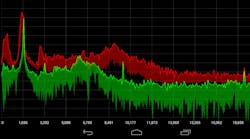Group delay is a critical parameter that helps to characterize the quality of a transmission channel. Group delay measurements are commonly performed with a vector network analyzer (VNA), which essentially steps through a frequency of range of interest and performs a user-specified number of measurements. However, an alternative method, which involves the combination of a spectrum analyzer and signal generator, can also be used to measure group delay. This method is the subject of an application note from Rohde & Schwarz titled “Group Delay measurements with Signal and Spectrum Analyzers.”
The application note begins with some basic theoretical information concerning group delay. It then explains how VNAs are used to measure the group delay of non-frequency converting components, such as filters and amplifiers. In addition, several techniques can be utilized to enable a VNA to measure group delay when frequency conversion does take place.
Multi-carrier group delay measurements are then discussed, as this technique essentially allows group delay to be measured with a spectrum analyzer together with a signal generator. While the typical VNA-based method is to sweep across a frequency range of interest, the multi-carrier method involves a multi-carrier signal that contains several sine waves. Each sine wave has a specific frequency and phase. By taking advantage of a multi-carrier signal, it is then possible to determine group delay over a given frequency range.
For the sake of comparison, the group delay of a bandpass filter was measured with both a VNA and a spectrum analyzer/signal generator test setup that used the multi-carrier method. The results from both measurements were in good agreement. Moreover, when utilizing the spectrum analyzer/signal generator method, the application note points out the importance of using attenuator pads when measuring a device-under-test (DUT) with high input or output reflections.
While the multi-carrier method offers the benefit of faster measurement times, some challenges are also associated with this approach. One challenge involves signal-to-noise ratio (SNR), which decreases as the number of carriers increase. Another challenge involves intermodulation-distortion (IMD) products.
Rohde & Schwarz, Mühldorfstrasse 15, 81671 Munich, Germany; (800) 837-8772

